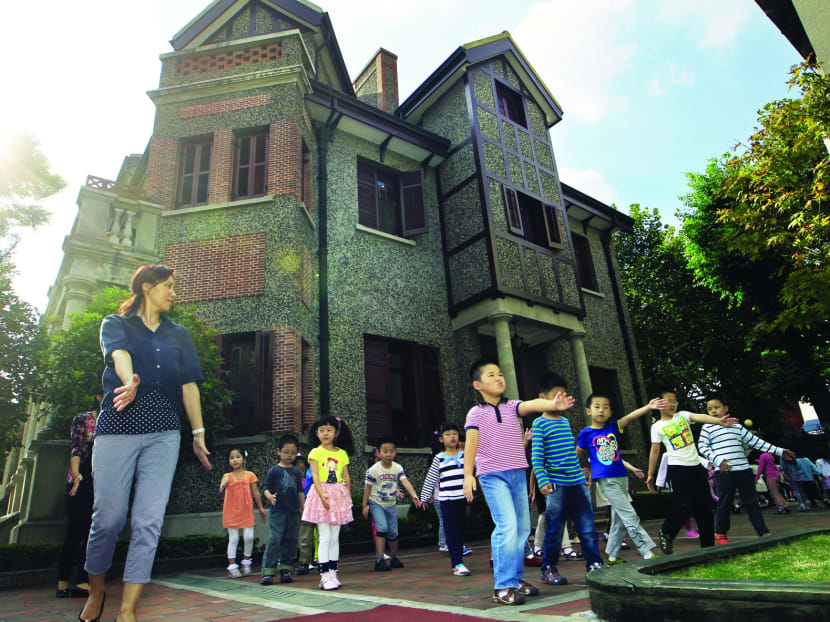Shanghai pre-schools’ all-play approach making parents sweat
In Shanghai, children attending government-run kindergartens are not taught how to read, write or count. They do not learn English or hanyu pinyin either.
Unlike kindergartens here, those in Shanghai that are run by the government are banned from teaching five and six year-olds reading, writing or arithmetic skills. Neither are they allowed to teach English or hanyu pinyin. Instead, the children play in outdoor obstacle courses, sing songs, draw and tell stories to their classmates for the most part of a typical day in class. Local authorities believe that a child between three and six years old should not be made to learn to write Chinese characters as doing so will dampen his or her interest in the Chinese langauge and the appreciation for it, as well as affect muscle development.
However, such an approach is under strain in Shanghai - one of China’s fastest growing and most competitive cities - as parents subjected to the one-child policy increasingly pay greater attention to their children’s academic development.
Last month, TODAY examined Hong Kong’s highly market-driven pre-school sector. In the second installment of our five-part special report on the pre-school systems of Asian cities, we focus on Shanghai which is seen as the standard bearer for pre-school education among Chinese cities.
SHANGHAI – No teaching of children to read, write or do mathematical sums. They are also not allowed to be taught English or hanyu pinyin. These are the cardinal rules for public kindergartens in Shanghai, which are under strain in a cosmopolitan city fronting China’s economic ambitions and where parents are paying greater attention on the academic development of their only child. But for now, most five and six year-olds play in outdoor obstacle courses, sing songs, draw and tell stories to their classmates for the most part of a typical seven-hour day at the public kindergartens. When TODAY visited Heng Li Jin Cang Kindergarten last month, children recited lyrics from a Wong Fei Hung movie soundtrack, and then sang along as they mimicked simple kungfu moves. Such activities not only help to train children in their oral, observational, memory and dexterity skills but also introduce them to elements of Chinese culture, said the centre’s principal Yu Haiping. At other kindergartens, the children role-played as customers or shopkeepers using cardboard props – this helps a child develop his or her social interaction skills, and is an important part of early childhood development given how there are limited opportunities to interact with other children at home under China’s one-child policy. In Starting Well, an early childhood education report published last year by the Economist Intelligence Unit (EIU) and commissioned by Singapore’s Lien Foundation, China ranked 42nd out of 45 countries in overall scores of accessibility, affordability, and quality. Shanghai – China’s largest and wealthiest city – offers the best pre-school education compared to the other cities, experts said. The curriculum across all public kindergartens – which is designed by each pre-school’s teachers but based on municipal guidelines – emphasises learning through guided play and centres around components such as daily life situations, exercise and games. English and hanyu pinyin are also omitted from the curriculum. Mr Qu Jia Jie, a pre-school education officer from the Shanghai Municipal Education Commission (SHMEC) Basic Education Department, said: “Language is a tool of communication and we feel that the learning of a language should be based on the child’s environment. Learning another language when a child is still learning his or her mother tongue may affect the child’s full grasp of one language.” The SHMEC holds a staunch view that making a child between three and six years old learn to write will dampen his or her interest in the Chinese langauge and the appreciation for it – because of the need for repetitive writing of the Chinese characters which it also believes would affect a child’s muscle development. Ms Chen Si, Research Assistant at East China Normal University’s Department of Early Childhood Education, added that letting a child in pre-school learn or acquire skills beyond what are expected of his or her age could cause the child to not pay attention in class when he or she enters Primary 1. However, the “all play” approach adopted by public kindergartens in Shanghai – since academic learning was removed from pre-school curriculum as part of education reforms in the ‘80s - and a child’s transition to an academic-intensive environment in primary school have increasingly come under public debate. Bending to the demands of parents and stemming from some preschool educators’ worry that their charges cannot cope in primary school, some public kindergartens risk flouting municipal guidelines and conduct English, hanyu pinyin and mathematics lessons in class. Professor Zhu Jiaxiong, Director and Chief Professor of the Institute of Early Childhood Education at the Chinese Society of Education, said: “It is impossible to make it a completely ‘play’ or ‘happy’ curriculum. The government does not want primary school curriculum to be used in preschools but the problem is if you just let them play, when they go into primary school, there will be trouble...because the learning speed in the primary school is too fast.” With some private kindergartens which charge higher fees offering academic learning, Prof Zhu added: “This won’t be a problem for children from well-to do families but it will be for poorer children.”The study trip to Shanghai was made possible by Lien Foundation.







